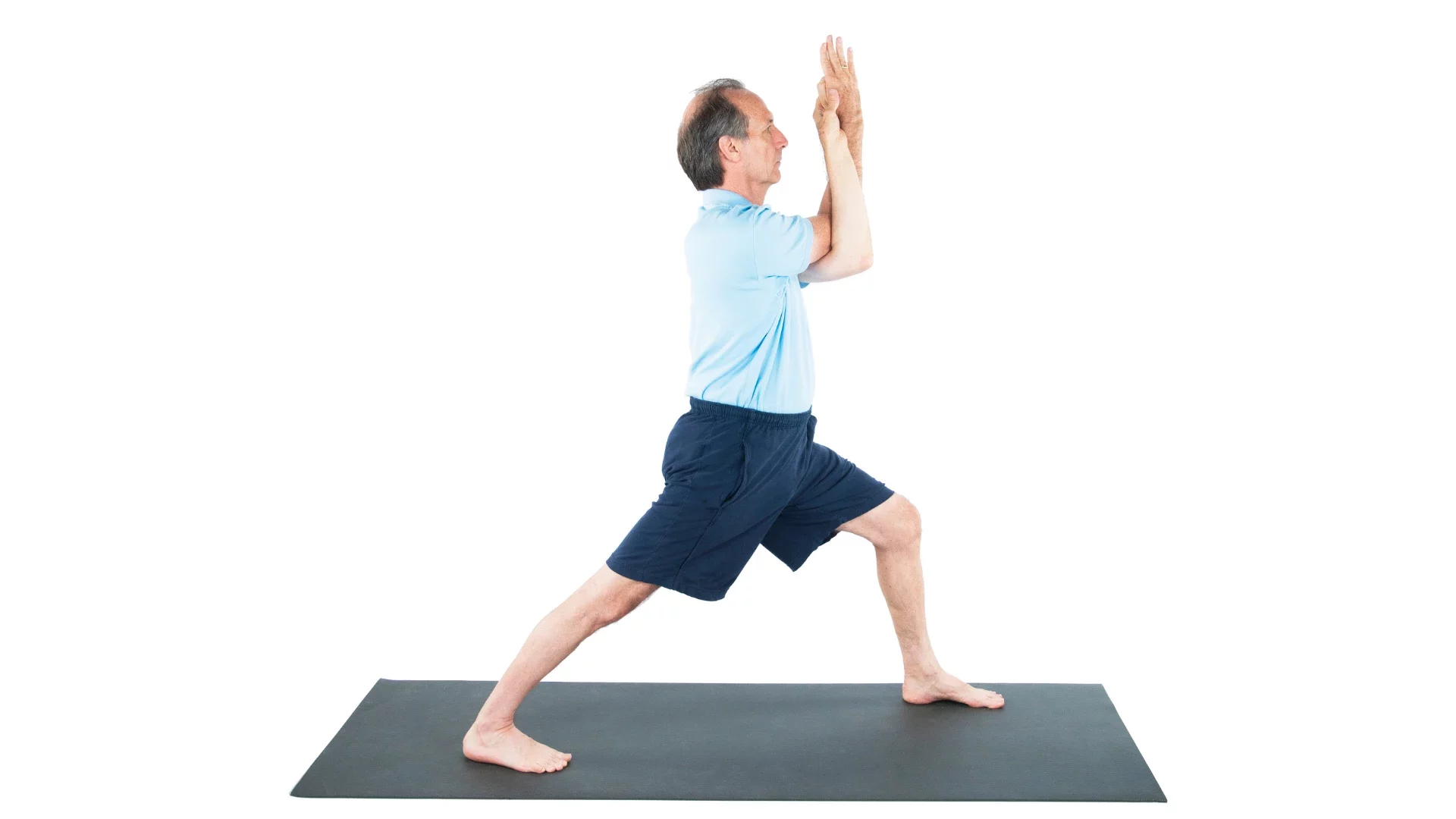Yoga Practice Tips for a Powerful Warrior I Pose in Yoga

Article At A Glance
Yoga’s Warrior I Pose (Virabhadrasana I) is a strength-building standing pose. If you find it challenging, you’re in very good company. The pose requires an extensive range of motion through the hips, knees,, and shoulders that may not be accessible to everyone. Here are some yoga practice tips and variations to make Warrior I Pose accessible to beginners and experienced practitioners alike.
If you find Warrior I Pose (Virabhadrasana I) a challenging yoga pose, you’re in very good company. In fact, I would argue it’s an advanced pose despite featuring it in Sun Salutation B (Surya Namaskar B) and “basic” pose lists. Warrior I Pose requires an extensive range of motion through hips, knees, and shoulders that few people can access. Let’s break it down a little and look at variations of the yoga pose for most bodies.
How to Practice Warrior I Pose in Yoga
- Start in Mountain Pose (Tadasana) at the front of your yoga mat with your feet hip-width apart.
- Take a big step back with your left foot, keeping your feet hips-width apart from left to right. The distance between your feet from front to back is an individual choice, depending on your body. For example, if you have sacroiliac (SI) joint issues, a narrower stance will help keep your joint in a healthier position.
- Keep the front foot toes pointing toward the front of the mat. The back foot will angle out a bit, but keep it mostly facing forward. This helps keep your left knee aligned. Ground both feet.
- Bend your front knee to roughly 90 degrees, although if you use a narrower stance, that angle will be greater than 90 degrees.
- Keep the back leg straight and extended out behind you.
- Do not try to “square” your pelvis to the front edge of your mat. Instead, allow the left side to move slightly back along with the left leg. Resist the temptation to tilt your pelvis forward.
- Lengthen your spine and lift through the crown of your head.
- Reach your arms up and overhead. Either press your palms together or extend your arms to be parallel.
- Lift your gaze toward your thumbs, but resist tilting your head back.
Benefits of Warrior I Yoga Pose
- Strengthens the legs and gluteal muscles.
- Helps us to feel grounded and steady.
- Lengthens the spine and the front of the body.
- Creates more space for the diaphragm and deep breathing.
- Lengthens the psoas muscles.
- Strengthens the arms.
Common Challenges in Practicing Warrior I Pose
- Trying to keep a neutral pelvis means most people will arch their back, particularly the lumbar spine.
- Pressing the palms together overhead doesn’t work for some people’s shoulders, so they may arch their back and flare the ribs to reach the arms up.
- Attempting to have the back hip face forward while externally rotating the leg, then internally rotating at the lower leg, puts pressure on the back knee. It also may cause SI joint dysfunction and could damage the hip joint. That is why it’s important not to try to face the back hip forward.
Practice Tips for an Easier Warrior I Yoga Pose

Every body is different, yet some cues can create much more ease in Warrior I Pose alignment for most people.
- Ground the front foot and add external rotation energy from the foot. Imagine you’re trying to screw the foot into the mat toward the pinky-toe side of the mat. While there is no movement of the foot, the connection to the earth is steadier, and the muscles activated in the leg change. This external rotation engages the gluteal muscles and can ease the burden on the quadriceps. It will also help to support the knee.
- Draw the front leg and hip back. This will help to stabilize the pelvis.
- Yoga teachers often cue the back foot at a 45- to 60-degree angle. This can create torque in the knee. Make the angle of the back foot 10 to 20 degrees. This may cause your heel to lift off the floor. That’s okay. Facing your back foot mostly forward will help minimize the external rotation at the back hip and give access to more extension of the leg. It will also help minimize rotation pressure at the knee.
- Keep your hands shoulder-width apart with external rotation at the shoulder for a more comfortable lift of the arms.
- Gaze toward the horizon. The body tends to follow where the gaze goes. When we look up, this often creates an arch in the spine and can cause neck tension. Keeping the gaze on the horizon can help reduce the arch in the back.
Variations of Warrior 1 Yoga Pose
If you still find it challenging for your body with the above cues, try the following variations of Warrior I Pose.
- Soften the lunge. If you don’t go as deep into the front knee bend and hip flexion, you may be able to keep the pelvis neutral and reduce strain on the lower back and SI joint.

- Practice arm variations. Rather than lift your arms over your head, keep your hands to heart in Prayer Position (Anjali Mudra). You could also do variations with Eagle Pose (Garudasana) (shown below) or Cow Face Pose (Gomukhasana) arms. These variations can benefit shoulder mobility without creating strain on shoulders or adding to arching the spine.

- Lift your back heel. If your back knee is under too much pressure, lift the back heel and turn Warrior I into a High Lunge Pose (Anjaneyasana). This will give more range to the extension of the back leg. Warrior I Pose is a strength-building standing pose. This article outlines the pose’s challenges and suggests variations for every body.

Also, read...
Warrior 3 Yoga Pose At the Wall: Variations with Props
Build Confidence and Strength With These 3 Tree Pose Variations
5 Ways to Power Up Your Practice with Yoga Props
Related courses
Journey to Center: A Yoga Guide to Unlock the Full Potential of Your Core
Yoga for Healthy Hips: Principles for a Safe Practice
The Essential Trinity of the Body: The Role of the 3 Diaphragms
Need an Energy Makeover? How Yoga Can Help You Boost Vitality

Erin Bourne (RYT500, YACEP) is a yoga teacher and yoga teacher trainer based in Seventeen Seventy (yes, the real town name) in Australia. She also teaches Pilates and other movement modalities; having come to yoga from an Exercise Science and education background, she is obsessed with learning and sharing about the body and movement. Erin shares her experience and knowledge through regular classes, teacher trainings, online courses, and writing. Her course offerings include 3D Anatomy and Resistance Yoga. Her writing includes the book A Yogi’s Guide to Fascia and numerous print and online published articles. You can find Erin’s creations through her website http://www.erinlbourne.com/







